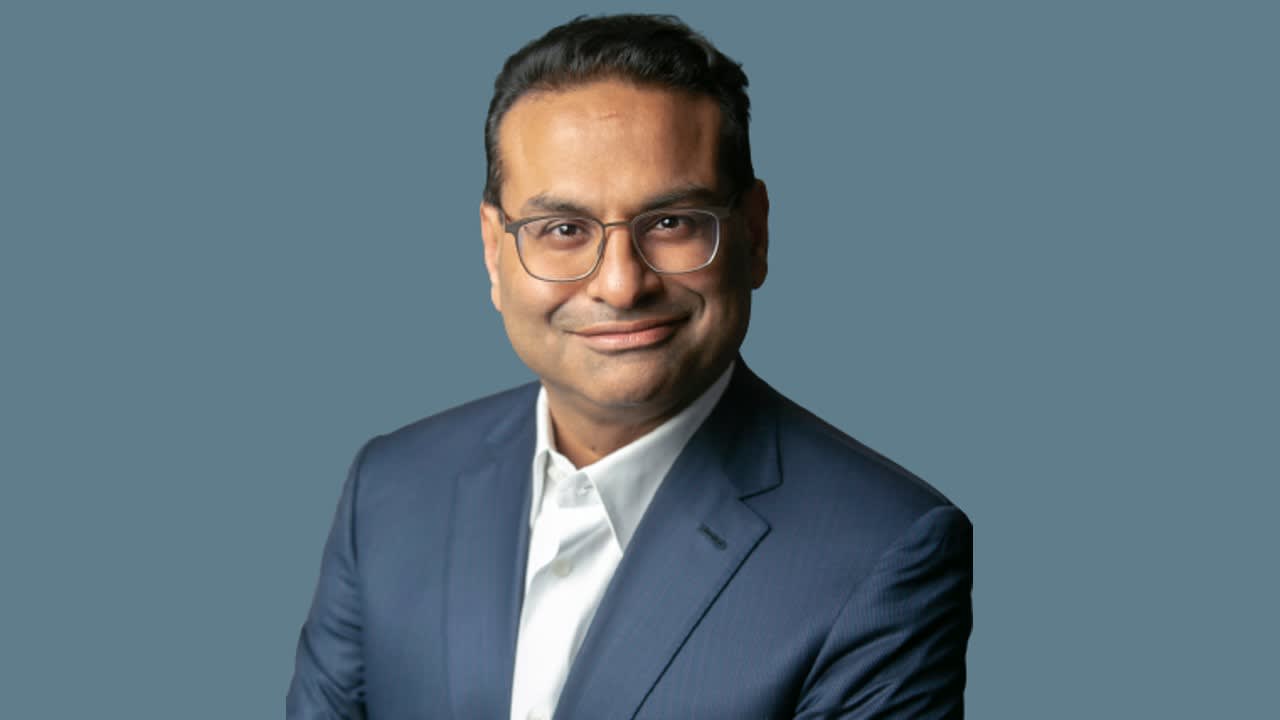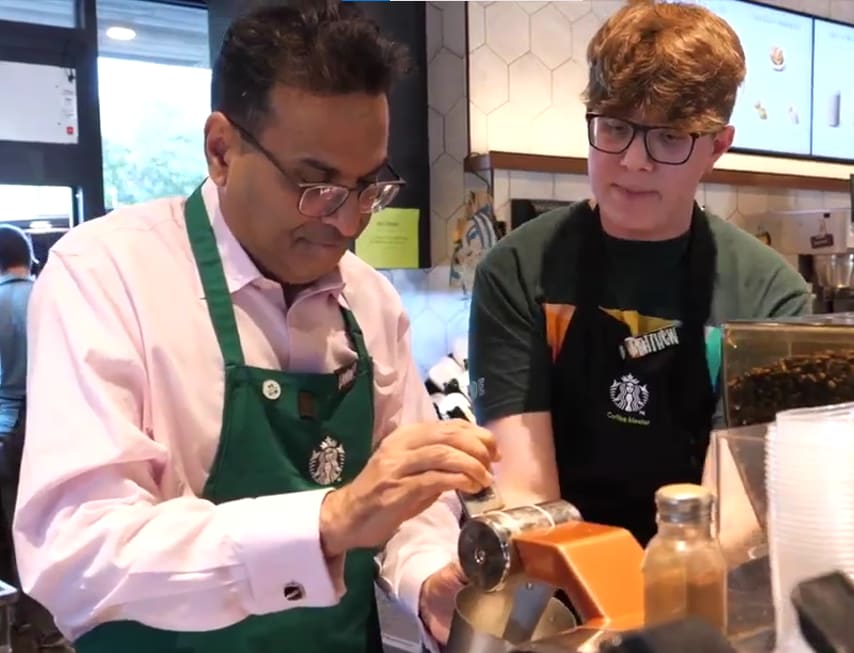Starbucks New CEO

Starbucks has appointed Laxman Narasimhan as its new CEO, succeeding Howard Schultz, who served as interim CEO after the departure of Kevin Johnson. Narasimhan, a seasoned executive with extensive experience in consumer goods and beverage companies, brings a wealth of knowledge and leadership to Starbucks.
Laxman Narasimhan’s Background and Experience
Narasimhan’s career spans over two decades, marked by leadership roles in prominent multinational companies. He previously served as CEO of Reckitt Benckiser, a global consumer goods company, where he led a turnaround strategy and achieved significant growth. Before that, he held various leadership positions at PepsiCo, including Chief Commercial Officer, where he played a crucial role in driving the company’s global growth strategy.
Narasimhan’s Vision for Starbucks
Narasimhan’s vision for Starbucks is centered around enhancing the customer experience, driving innovation, and fostering a culture of inclusivity and belonging. He emphasizes the importance of “listening to customers, partners, and communities” to understand their needs and preferences. He also aims to leverage technology to personalize the Starbucks experience and offer greater convenience to customers.
Key Priorities and Strategies for Growth
Narasimhan’s key priorities for Starbucks include:
- Expanding Starbucks’ global reach: Narasimhan plans to accelerate Starbucks’ international expansion, targeting key markets with significant growth potential. He will focus on adapting the Starbucks experience to local tastes and preferences while maintaining the brand’s core values.
- Introducing new products and experiences: Starbucks is known for its innovative beverage offerings, and Narasimhan plans to continue this tradition by introducing new products and experiences that cater to evolving customer preferences. This could include exploring new beverage categories, expanding food offerings, and enhancing the Starbucks Reserve experience.
- Enhancing the customer experience: Narasimhan believes that a positive customer experience is crucial for Starbucks’ success. He plans to invest in technology to personalize the Starbucks experience, offer greater convenience, and enhance the overall customer journey. This could involve initiatives like mobile ordering, personalized recommendations, and improved store design.
- Investing in its employees: Narasimhan recognizes the importance of investing in Starbucks’ employees, known as partners. He plans to focus on employee development, training, and well-being to create a more engaged and productive workforce.
Key Challenges and Opportunities for Starbucks: Starbucks New Ceo

Starbucks, a global coffeehouse giant, faces a complex landscape of challenges and opportunities in the current market. While its iconic brand recognition and loyal customer base provide a strong foundation, navigating evolving consumer preferences, intensifying competition, and economic uncertainties requires strategic adaptation.
Competition and Market Dynamics
The coffee industry is highly competitive, with a diverse range of players from established chains like Dunkin’ Donuts and McDonald’s to independent cafes and specialty roasters. Starbucks faces competition on multiple fronts:
- Price Competition: Budget-conscious consumers are drawn to lower-priced alternatives, leading to price wars in the market. Starbucks’ premium pricing strategy may limit its appeal to price-sensitive customers.
- Convenience and Accessibility: The rise of mobile ordering, delivery services, and on-the-go consumption has increased the importance of convenience. Starbucks needs to maintain its competitive edge in accessibility and speed of service.
- Customization and Innovation: Consumers are increasingly demanding personalized experiences and innovative offerings. Starbucks must adapt its menu and offerings to cater to evolving tastes and preferences, such as plant-based options and unique flavor profiles.
Changing Consumer Preferences and Trends
Consumer preferences are evolving rapidly, driven by factors such as health consciousness, sustainability, and a desire for unique experiences. Starbucks must respond to these trends to remain relevant:
- Health and Wellness: Consumers are increasingly prioritizing health and wellness, seeking beverages with lower sugar content, plant-based options, and healthier ingredients. Starbucks has introduced a range of healthier choices, such as dairy-free alternatives and protein-packed smoothies, but must continue to expand its offerings in this area.
- Sustainability and Ethical Sourcing: Consumers are increasingly demanding transparency and ethical sourcing practices from brands. Starbucks has made strides in its sustainability initiatives, such as ethical coffee sourcing and waste reduction programs. However, it needs to continue to demonstrate its commitment to environmental and social responsibility.
- Experiential Consumption: Consumers are seeking experiences beyond simply purchasing a product. Starbucks has fostered a sense of community and social interaction in its stores, but it must continue to innovate to create unique and memorable experiences.
Economic Uncertainties and Global Challenges
Starbucks operates in a global market, subject to economic fluctuations, geopolitical events, and evolving regulatory landscapes. The company must navigate these challenges:
- Inflation and Cost Pressures: Rising inflation and supply chain disruptions are putting pressure on Starbucks’ costs. The company must balance price increases with maintaining affordability for customers.
- Labor Shortages and Wage Pressures: The tight labor market is leading to increased competition for talent and wage pressures. Starbucks needs to attract and retain employees by offering competitive wages and benefits.
- Geopolitical Risks: Global events, such as political instability and trade tensions, can impact Starbucks’ operations and supply chains. The company must have contingency plans in place to mitigate these risks.
Opportunities for Growth and Innovation
Despite the challenges, Starbucks has significant opportunities for growth and innovation:
- Plant-Based Options: The demand for plant-based alternatives is growing rapidly. Starbucks can capitalize on this trend by expanding its plant-based menu and promoting its existing options.
- Sustainability Initiatives: Starbucks can further enhance its sustainability credentials by implementing more ambitious environmental and social responsibility programs, such as reducing its carbon footprint and supporting local communities.
- Digital Innovation: Starbucks has already made significant strides in digital innovation, with its mobile ordering and loyalty programs. The company can further enhance its digital offerings by integrating new technologies, such as personalized recommendations and augmented reality experiences.
Starbucks’ Position Relative to Competitors
Starbucks holds a strong position in the coffee market, with a global brand presence, loyal customer base, and established infrastructure. However, it faces challenges from competitors:
- Strengths: Brand recognition, customer loyalty, strong infrastructure, innovation in product development, and digital capabilities.
- Weaknesses: Premium pricing, potential for customer fatigue, vulnerability to economic downturns, and competition from smaller, more agile players.
Impact of the New CEO on Starbucks’ Future

Narasimhan’s appointment as Starbucks’ CEO marks a significant turning point for the coffee giant. His extensive experience in consumer goods and digital transformation, coupled with his focus on operational efficiency and customer-centricity, suggests a potential shift in Starbucks’ long-term strategy and financial performance.
Impact on Starbucks’ Long-Term Strategy and Financial Performance, Starbucks new ceo
Narasimhan’s background in consumer goods and digital transformation could lead to a renewed focus on innovation and customer experience. He might introduce new products, services, and digital initiatives to enhance customer engagement and drive revenue growth. Additionally, his emphasis on operational efficiency could result in cost optimization and streamlined processes, potentially boosting profitability.
Impact on Starbucks’ Brand Image, Customer Loyalty, and Employee Morale
Narasimhan’s leadership could impact Starbucks’ brand image, customer loyalty, and employee morale in various ways. His commitment to customer-centricity might lead to improved customer service and personalized experiences, enhancing brand perception. However, significant changes to operations or product offerings could initially create uncertainty among customers and employees, potentially affecting loyalty and morale.
Potential Scenarios for Starbucks’ Future under Narasimhan’s Leadership
The success of Narasimhan’s leadership will depend on various factors, including his ability to navigate evolving consumer preferences, maintain Starbucks’ brand image, and foster a positive work environment. The following table Artikels potential scenarios for Starbucks’ future under Narasimhan’s leadership:
| Scenario | Key Outcomes | Potential Impact |
|---|---|---|
| Successful Innovation and Digital Transformation | Increased revenue growth, improved customer engagement, enhanced brand image, improved operational efficiency | Starbucks becomes a leader in the coffee industry, with a strong focus on innovation and digital transformation. |
| Challenges in Adapting to Changing Consumer Preferences | Declining sales, loss of customer loyalty, negative brand perception, increased competition | Starbucks struggles to adapt to changing consumer preferences and faces challenges from competitors. |
| Employee Dissatisfaction and High Turnover | Decreased productivity, negative impact on customer service, increased operational costs | Starbucks experiences high employee turnover and struggles to maintain a positive work environment. |
| Successful Integration of Sustainability Initiatives | Enhanced brand image, increased customer loyalty, reduced environmental impact | Starbucks becomes a leader in sustainable practices, attracting environmentally conscious customers. |
Starbucks new ceo – Starbucks has a new CEO at the helm, and while his vision for the coffee giant is sure to be interesting, one can’t help but wonder about the compensation package that comes with the job. After all, the brian niccol salary is a hefty sum, and it’s likely that the new CEO will be aiming for similar levels of financial reward.
Only time will tell how the new leadership will impact the company’s future, but one thing is for sure: the coffee game is about to get a whole lot more interesting.
Starbucks’ new CEO, Laxman Narasimhan, faces a daunting task in reviving the coffee giant. He’ll need to navigate a shifting landscape, where consumer tastes are evolving and competition is fierce. Perhaps he can draw inspiration from the success of Brian Niccol’s transformation of Taco Bell , where he reimagined the brand and revitalized its menu.
Niccol’s focus on innovation and customer experience could be a roadmap for Narasimhan as he seeks to re-energize Starbucks and capture the hearts (and wallets) of a new generation of coffee lovers.
